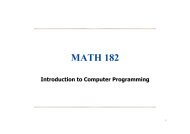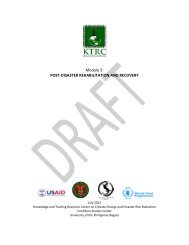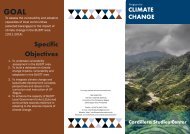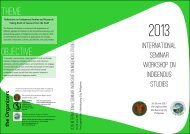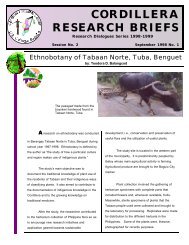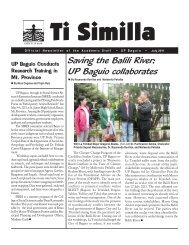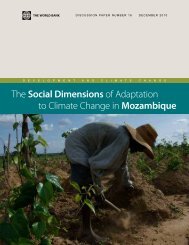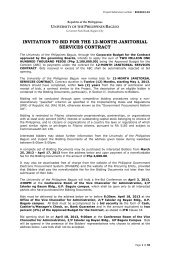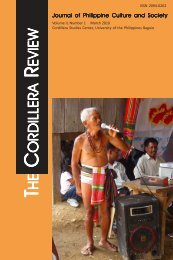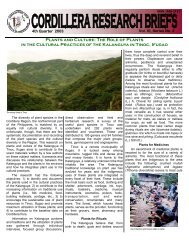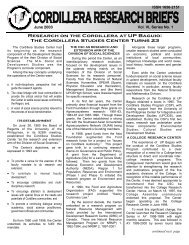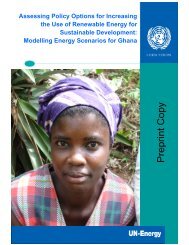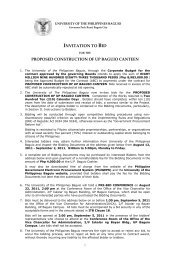September - UP Baguio
September - UP Baguio
September - UP Baguio
You also want an ePaper? Increase the reach of your titles
YUMPU automatically turns print PDFs into web optimized ePapers that Google loves.
Ti SimillaISSN 0119-6634O f f i c i a l N e w s l e t t e r o f t h e A c a d e m i c S t a f f • U P B a g u i o • <strong>September</strong> 2008<strong>UP</strong> <strong>Baguio</strong> rallies to save forest parkLed by Chancellor Priscilla Macansantosand joined in by Bishop Carlito Cenzon, morethan a thousand students, faculty, administrativepersonnel and administration officials of<strong>UP</strong> <strong>Baguio</strong> marched from the campus on <strong>September</strong>3, 2008 to form a human chain aroundthe 1.4 hectare forested area adjacent to the<strong>Baguio</strong> Convention Center. After the barricade,Chancellor Macansantos directed therallyists to march around the SM Complexbefore coming back to the <strong>UP</strong> <strong>Baguio</strong> campus.The contingent was stopped by <strong>Baguio</strong>police and SWAT vans that barricaded the rallyroute at the top of Session Road, just metersaway from SM <strong>Baguio</strong>. The Chancellor’s judgmentcall was for the contingent not to challengepolice resistance, but to continue registeringcollective protest against corporate greedand environmental degradation.The rally dramatized <strong>UP</strong> <strong>Baguio</strong>’s unqualifiedopposition to the plan of the SM DevelopmentCorporation, entered into through ajoint venture with the Government ServiceInsurance System, to build four 14-storey condominiumsand a commercial complex on thesaid site, including “development” of the ConventionCenter and the Sunshine Park. Thecondotel project will necessitate the cuttingdown of close to a thousand pine trees, one ofthe few pine stands remaining in the city. Theproject will need the City Council’s approvaland go-signal. Since the Council’s initial reviewof the plan early this year, opposition fromboth city officials, civic groups and academehas grown. Questions on the status of ownershipof the forest park will likewise need to besettled. In the City’s zoning law, the area is an“institutional zone,” on which no developmentby any private entity is allowed. <strong>UP</strong><strong>Baguio</strong>, in alliance with other civic-mindedaggrupations, will continue this campaign.(Sources: <strong>Baguio</strong> Midland Courier, 7 <strong>September</strong>,2008; Outcrop, <strong>September</strong> 2008) Marching against commercial enterprise undertaken at the expense of the environmentChancellor Priscilla Macansantos (center) leads the campaign
From <strong>UP</strong> <strong>Baguio</strong> University CouncilA Call toVigilanceStatement/Photos<strong>September</strong> 3 Face-OffRally contingent formsa human chain aroundConvention CenterForest ParkWe are unwitting recipients of a TrojanHorse. The trap door has flung open for easyentry of the menace of disruptive change andbaleful forces that threaten to have their wayin our home. It is truly strange how hospitalitycan readily mutate into prostitution.Since then our lives have not been the same,although in certain respects not necessarilybetter. We recognize the inevitability of changeand ours is not simply an appeal for retreatinto the illusory world of debilitating nostalgia.It is a plea for the exercise of a fair modicumof sanity or of noble restraint on greed.We issue a call for vigilance. No space issafe from the creep of commercialization andour city must not fall prey to the scourge ofunbridled urbanization. Complacency hasbeen our undoing more than once before, andit shall be handmaiden to our city’s ultimateruin.A recent exhibit of photographs says it all.One image presents a panoramic view of<strong>Baguio</strong>’s central business district. On one end,the SM megalith dominates the space, severelyout of place and comparable to a discordantbuck tooth— or a pimp’s gold-capped fang—marring <strong>Baguio</strong>’s otherwise wholesome smile.Not without irony, the exhibit was housed atone of the basement levels of SM <strong>Baguio</strong>. Talkabout shooting yourself in the foot! We laugh,but this is laughter which verges on pain. Developmentmust inevitably ensue, but at whatcost? Certainly matters of practicality andprofit must not eclipse good sense and generalwell-being. Ultimately, the exercise of prudencecan temper the injurious consequencesof urbanization run amok.Protect our city’s natural allure. We mustcollectively stand guard over the Forest Parkand whatever else is left of our home. We cannotafford to sleep soundly lest the foul innardsof the gift horse pounce on us oncemore. Bishop Carlito Cenzonregisters supportRallyists mass atSession RoadrotondaProf. Evangeline Ramprovides updates onSMDC/GSIS plans<strong>UP</strong>B officialdomsquares off with police2 TI SIMILLA <strong>September</strong> 2008
Dr. Ian Jasper Agulo, Associate Professorof Physics from the College of Science,delivered a Professorial Chair lectureon July 21, 2008, reporting the initial resultsof his pioneering study on the Dynamicsof Non-equilibrium Quasiparticles in theSuperconducting Cold-Electron Bolometer.To understand the study in perspective (andrender the study’s title less bothersome), thefollowing bit of scientifichistory may be helpful.In 1965 at New Jersey,Arno Penzias andRobert Wilson of BellTelephone Laboratorieshad just built a radiometerfor astronomyand satellite communicationapplications. Duringthe instrumentationtest, their antenna detecteda faint microwaveradiation which theycould not account for.At first they thoughtthat the signal wascaused by pigeons roostingnearby. But thenthey noticed that the radiationseemed to emanatefrom all directions in space and had,by their measurements, a thermal signatureof 3.5 Kelvin. They had not the slightestidea that what they stumbled upon will resolve,once and for all, the decades-old debateson how the universe came to be.Of the numerous theories trying toexplain the origin of the universe, mostfailed to stand against experimental datagathered through years of cosmological observations.By the 1950s, only two remained— the Steady-State theory and theBig Bang theory. The former held that theuniverse was homogeneous in space and timeReportProfessorial Chair lecture in PhysicsThe Universe, Dark Energy andQuasiparticle Dynamics Alipio Garcia“Galaxies are accelerating away from each other”and had remained like that forever — essentially,that the universe existed in “a steadystate.” The latter, more controversial in itsclaims, arose from the observation made byEdwin Hubble in 1929 that the galaxies aremoving away relative to each other. Thisobservation implied that the galaxies musthave been nearer each other in the past, andwith a little stretch of imagination, that thegalaxies may have come from a single point.The creation of the universe started whenthis singular point exploded for some reasonin a cataclysmic event called the “bigbang.”Among the supporters of this theorywere George Gamow, Stephen Hawking,and the Princeton physicist Robert Dicke,the designer of the radiometer used byPenzias and Wilson. Dicke believed that ifthe universe started from the Big Bang thenthere must be a remnant radiation from thatevent. Dicke calculated the temperature ofthis remnant radiation, considering the expansionof the universe in today’s measureto be in the neighborhood of 3 Kelvin.A few years later, when Penzias and Wilsonreported their observation, there wasno doubt in Dicke’s mind that it was thecosmic background microwave (CMB) radiationhe was talking about. Penzias andWilson’s discovery had planted the Big Bangtheory on solid ground, and ushered in anunprecedented era of cosmologicalinvestigations.By 2003, the age, composition,geometry, and therate of expansion of theuniverse had been discernedto within experimentalaccuracy. Thiswas also the year whentwo independent teamsof astronomers, using entirelydifferent methods,came to the same conclusion– that the universeis made up of 4% ordinarymatter (stuff bywhich everythingaround us is made of),23% exotic matter (stuffyet unknown), and 73%dark energy.Dark energy is believed to be the causeof the continued expansion of the universe.What is more disturbing is the fact that thegalaxies are accelerating away from eachother, when Einstein’s general theory ofrelativity predicts that gravity should, bynow, start pulling galaxies toward eachother. That it is a force far stronger thangravity is pretty much everything that weknow of dark energy at his moment. Thepursuit to understand the nature of darkenergy is what drives astronomers today.As Agulo put it, “To accomplish this miscontinuednext page<strong>September</strong> 2008 TI SIMILLA 3
Reportsion, a new generation ofbolometers with increasedsensitivity is required.”A bolometer is a devicethat measures theintensity, power or temperatureof electromagneticradiation (e.g., radiowaves, microwaves,x-rays, visible light, etc.).Bolometers vary interms of architecture,principle of operation,and types of materialsused. While almost allbolometers in use todayutilize semiconductormaterials, Agulo’s deviceis the first of its kind toemploy both superconductorsand an electroncooling mechanism.The idea of electroncooling (hence the name cold-electron bolometer)was originally conceived by Prof.Leonid Kuzmin of Chalmers University ofTechnology in Sweden. Prof. Kumin wasDr. Agulo’s mentor as they worked togetheron the fabrication of the world’s firstsuperconducting cold-electron bolometer(SCEB).The idea was to increase the bolometersensitivity by cooling the absorber metal(the part of the bolometer that absorbs theincident electromagnetic radiation). Thecooling process is done by the superconductorwhich acts to channel away the hotelectrons from the absorber. By doing so,every increase in electron energy in the absorberis mainly due to the incident photonenergy. This ingenious design allowsthe SCEB to detect an incident power of afew attowatts (1 attowatt = 10 -18 watt). Inperspective, the SCEB can detect the lightfrom an ordinary refrigerator bulb a millionkilometres away in outer space!To improve the accuracy of the device,it is necessary to understand the complexdynamics of the particles involved inthe absorption-tunnelling processes. Particleslike electrons, holes and phonons playAn Atomic Force Microscope (AFM) image of the Cold-Electron Bolometer (CEB). The Superconducting CEB is createdby replacing the normal metal absorber with a superconductor.intimate roles in the device operation. Thepresence of a superconductor in the devicefurther complicates the problem. In superconductors,electrons pair up (so-calledCooper pairs) to conduct electricity withabsolutely no resistance. When a pair breaksup, the electrons become quasiparticles,with surprising behavior. The break-up rateof Cooper pairs is strongly dependent ontemperature increase.Utilizing numerical and analytical techniquesto study quasiparticle dynamics, Dr.Agulo was led to more problems than solutions.Mathematically, non-equilibriumproblems are among the hardest in physics.Physically, the processes are complex andstatistical. Electrons from the absorbermetal that tunnel into the superconductingregion also become quasiparticles. The tunnellingrate of these quasiparticles in theSCEB has not been measured and with noexisting model yet that incorporates tunnellingrates, an analytical approach to theproblem becomes critical.From numerical simulations, using aquantum mechanical model of a rectangularbarrier potential, Agulo was able to obtainresults on the temporal evolution ofthe quasiparticles at different regions in thedevice. He realized that a more realisticsimulation is necessary to yield more meaningfuldata. For one, the barrier potentialas seen by the tunnelling electrons is moretriangular rather than rectangular in shape.The lack of faster and dedicated computers,not to mention the lengthy computationaltimes, is a major obstacle in this study.At this point it appears that Agulo has noother recourse but once again to tackle theformidable equations toward an analyticalsolution to the dynamics problem. Hopefully,Dr. Agulo, with a little help fromour mathematicians, will finally come upwith a solution, and his efforts may proveuseful in understanding the nature of darkenergy. 4 TI SIMILLA <strong>September</strong> 2008
ProfileBalik Scientist Program: Department of Science and TechnologyDr. Nory Ison: Visiting Scientist Grace SubidoA statistics and computer science expert comes home to help “accelerate the flow of technologies”The conversation with Nory Ison is confirmationthat stereotypes are, more oftenthan not, misplaced. “I’m just like everyoneelse,” he reveals, with a respectable historyof basketball, martial arts and the requisiteshare of “things” done during his youngeryears. The biggest adjustment for him thusfar is having to get used to people callinghim “Sir.”Dr. Norberto Ison, Balik Scientist, completedhis Bachelor’s Degree in AgriculturalStatistics, and Master’s inStatistics and Computer Science at<strong>UP</strong>LB, Ph.D. in Statistics at the Universityof Kansas and a Post-Doctoratefrom the University of Waterlooin Canada. In the past ten years,he was connected with various academicinstitutions in the US andCanada.He taught part time while incharge of Departmental OnsiteComputing Services at the Universityof California at Berkeley, where hewas given an award for excellence inmanagement for outstanding administrativeskills in AY 2003-04. At theUniversity of Guelth in Ontario,Canada, he was in charge of computing servicesand consulting for faculty and dataanalysis. He is currently with the GraduateSchool of the Simon Fraser University inCanada where he has filed for a leave ofabsence while he is back in the Philippinesas a Balik Scientist.The Balik Scientist Program of the Departmentof Science and Technology(DOST) seeks to “encourage [Filipino Scienceand Technology experts] to return orreside in the Philippines, and share their expertisein order to accelerate the scientific,agro-industrial and economic developmentof the country.” Balik Scientists are on contractwith the government to share their expertisein various academic and other publicand private institutions “in order to acceler-ate the flow of technologies and stimulatethe development of new or strategically importanttechnologies that are vital to nationaldevelopment and progress.” Two programsare open to Balik Scientists—the two-tothree-year Long Term Program, and theShort-term Program, which Dr. Ison is onthis time at <strong>UP</strong> <strong>Baguio</strong>, covers a period ofat least one month.The decision to come back was all his,“Teaching is a productive, rewarding enterprise”he proffers, partly because the program providedthe opportunity to be able to teach,which, given the chance he would like to dopermanently. “Teaching is an interesting, rewarding,and productive enterprise,” he says.“You learn about content, about students,about imparting knowledge to students.”For this, <strong>UP</strong> <strong>Baguio</strong> seemed an interestingchoice. “<strong>Baguio</strong> is such a nice place,” he says.He adds that he still has to explore the cityagain, especially as many changes have comeabout since the last time he was here. That<strong>UP</strong>B is a very young institution also stirredhis curiosity. “Statistics is not static,” he says,“and I’m interested in learning new things.”Being at <strong>UP</strong> <strong>Baguio</strong> for the past monthshas sparked some ideas. “Statistics is importantin many fields of study,” he notes. Atpresent, he sees possible contributions in elementarystatistics in the subject areas ofMathematics and Biology. He likewise notesthe importance of statistics in the Social Sciencesand Communication fields. “Good useof statistics enables full use of data and gooduse of resources,” he says. He likewise hasideas and possible suggestions for computingservices and the use of computers. Headds, however, that changes will have to comein slowly, and a major limitingfactor is the time considerationin his assignment to the University.The stint at <strong>UP</strong> <strong>Baguio</strong> is thesecond time around for NoryIson as Balik Scientist. Previously,he found himself back in hishome town at <strong>UP</strong> Los Baños toset up the computer center.Given the opportunity, he wouldnot hesitate to come back again,he adds, perhaps for a longer periodof time.Being away for an entire decadehas allowed him to lookback home with a wider perspective.“As a people, the Filipinosseem to be getting better,” hesays. “The Philippines has problems, politicalissues, corruption. But corruption happenseverywhere and not just in the Philippines.It is just that here, matters are exacerbatedby economics. We get it where it hurts.”He is quick to add that the mechanism isthere for changes to happen and for him,there is need for patience and no choice butto be optimistic.It is perhaps hope that, for the Balik Scientist,compels the eternal return (apologiesto Nietzsche). And, with this particular BalikScientist comes the realization that behindeach nondescript statistical point is indomitablehuman spirit, resolute in its goal not tobecome just another statistic in a governmentchart. <strong>September</strong> 2008 TI SIMILLA 5
ReportCordillera Studies Center Public LectureScience in 19th Century Philippines Ben FernandezFoundational progress in science and technology predated colonialismIn his second public lectureentitled “The Science of Natureand the Nature of Science in theNineteenth Century Philippines,”held on July 29, 2008 at <strong>UP</strong><strong>Baguio</strong>, Dr. Greg Bankoff explainedthat when the Americansarrived in the Philippines they expectednot to find much scientificadvancement. This may have ledthem to conclude that the Spaniardsaccomplished nothing but exploitation.So the Americans didwhat they could to help the Philippinesrise from the ashes. But inreality, Bankoff added, the Spaniardsintroduced a number of advancementsin science and technologyto the Philippines. Althoughit was not an oasis of researches, itwas not a desert either.One of the most significant contributionsof the Spaniards,Bankoff notes, was the establishmentin 1858 of the Manila BotanicalGarden, situated along the PasigRiver. This botanical garden exhibiteda number of plant species endemic tothe Philippines. In 1863 a Forestry Departmentwas also established, aimed at doing asurvey of Philippine trees and regulatingrampant deforestation. Felled trees wereused for building communities, water vesselsfor war, and galleons for trade. Bankoffexplained that the Forestry Department washeaded by Spaniards but was manned byFilipinos who did most of the job.Bankoff also elaborated on the ManilaObservatory that was built at theAteneo de Manila in 1865. The observatorymade a name by issuing timely warnings toshipping and coastal authorities around theSouth China Sea. This was followed by thebuilding of other observatories in neighboringcountries, but the Manila Observatorywas the initial lynchpin in the network.Equipment were imported from Europebut scientists in the Philippines introducedmodifications that improved observatoryfunctions. Bankoff cited thebarocyclonometer which was developed inthe Philippines around 1897. This new gadgetcombined the functions of an aneroidbarometer and a cyclonometer, and gavebetter storm warnings.Jesuit scientific writings cited that theManila Observatory was also later expandedto become a Seismological Observatory.It then served as the center for thestudy and observation of earthquakes in thecountry.Bankoff also spoke of the mystery ofthe shrinking horse. The Spaniards wonderedwhy the horses that they broughtto the country seemed to have grownsmaller. The horses that they transportedwith them were suited for battle and transportof heavy loads. However, when thesehorses arrived in the Philippines, theyshrank and became less useful to the Spaniards.They believed that if the horsesshrank, they can be brought back to theiroriginal state. This was one of the concentrationsof zootechny, a new field that focuseson breeding. Bankoff also said thatdebates on Darwinian vs. Lamarckianviews were a hit in the country. Affectedby the international shift, belief in theFrench theories was replaced andDarwinianism won out.Dr. Bankoff clarified that the Spaniards,just like the Americans, didn’t arrive in thePhilippines only to find zero progress inscience and technology. He mentioned thekarakao, a water vessel used by pre-colonialFilipino communities for trade withneighboring countries. Accounts, Bankoffnoted, describe the vessel to be a lot fasterthan any European vessel and could carrymore passengers, too. This inspired theSpaniards to utilize the skills of Filipinos inbuilding boats and galleons.Regarding precolonial architecture inthe country, Bankoff described designs thatwere adaptive to the environment, mentioningexamples like the raised floors of dwellingsin places where floods were frequent.Though not too many records have beenfound to provide a fuller picture, enoughfindings point to significant know-how inscience and technology in precolonialPhilippines. 6 TI SIMILLA <strong>September</strong> 2008
ReviewCollege of Arts and Communication/OpenSpaceProjectsTonyo/Pepe staged at <strong>UP</strong> <strong>Baguio</strong> Angela Buenafe<strong>Baguio</strong>-based actor/director Karlo Altomonte speaks on producing historical playsby Malou Jacob and Rene VillanuevaOn August 15, 2008 <strong>UP</strong> <strong>Baguio</strong> timetravelled inside the minds of two great Filipinorevolutionaries – General AntonioLuna (Tonyo) and Dr. Jose Rizal (Pepe)through the staging of two plays, Tonyo,written by Rene Villanueva, and Pepe, byMalou Jacob. The production was part ofthe celebration of Buwan ng Wika, as setby the College of Arts and Communicationof <strong>UP</strong> <strong>Baguio</strong>, in coordination withOpenSpaceProjects under the direction andacting of KarloM a r k oAltomonte (whoportrayed bothLuna and Rizalin the said plays).Tonyo/Pepe,originally writtenas separatemonologues, focusedon Luna’sand Rizal’sstruggles to beheard and understood,on themisrepresentationsof theirendeavours forthe country, andthe views or interpretationsofthese heroes onwhat kind of revolution they thought thePhilippines needed. Tonyo/Pepe ended brilliantlywith Karlo Altomonte resonatingDr. Jose Rizal’s desperate search for theyouth who would save the country froman aging and dying spirit.Since 1995, Karlo Altomonte had alreadythought of putting up a theatre groupwhile he was working with TanghalangPilipino (the resident theatre company ofthe Cultural Center of the Philippines) forseven years. He wanted to be part of agroup that explored and offered more versatileproductions. Altomonte cites that“most, if not all, theatre groups in Manilausually stick to a particular genre (Rep’sBroadway-ish productions, CCP’s Filipinoclassics and Filipino translations of Westernclassics, Bulwagang Gantimpala’s “curriculumtheatre,” etc.). When Altomonteco-directed and co-produced a benefit concertat the Remedios Circle in Malate thatsummer, they needed an entity for representation(in order to be given permits,when applying for sponsors, etc.) so he hadto found a theatre group. Sitting in the smallopen space in the middle of RemediosCircle in Malate, Altomonte thought thatthis seemed the destined name for a theatregroup that “would explore all creativepossibilities in staging productions perfectly.”Changing their theatre name to“Projects” instead of “Productions” wasmeant to encompass their ability to exploreforms of expression other than theatre.Altomonte was introduced to Tonyo/Pepe as a stage manager for TanghalangPilipino’s production of Tonyo, Pepe at Pule,(the third one being a monologue on thelife of Apolinario Mabini). That productionwas toured all over the country andran for more than a year, performed by differentactors almost every single time. As astage manager, Altomonte’s task was to rehearsethe new actors every time they stagedit, and that’s probably how Karlo came toperform theplays with suchdepth [heneeded to understandthemdeeper in orderto direct theother actors].“I had to, as astage managerand as de factoassistant directorexplainingthe director’sdirections/blocking/etc.to the actors,”he relays.OpenSpacestaged the playsfor the firsttime in <strong>Baguio</strong>in 1998. Altomonte felt that the thirdmonologue, Pule, “took away the symmetryof the performance, so I decided to takethe third one out and just present Tonyo/Pepe. We have been performing the playalmost every year since then: from variousvenues in <strong>Baguio</strong> to Kabayan, Pangasinanto Ilocos, all the way down south toBatangas and Camarines Norte.”On his directorial role, Altomonte comments:“My concern is to tell the story ofcontinued on page 12<strong>September</strong> 2008 TI SIMILLA 7
EssayTeaching Broadcasting Arjay ArellanoAn instructor honed in media studies trains his students towards accountabilityI have always been fascinated by the impactof broadcast media on our lives. I grewup watching various TV programs, makingme wonder what kind of invisible pullthese shows have on their viewers. For instance,I couldn’t help but marvel at thekind of motivation game shows give tomany Filipinos, or the kind of empathyprimetime soap operas cultivate in their audience.In the news and public affairssphere, broadcast mediahas proved itself well-versedin highlighting human emotionsand creating atmospheresof tension and fear.Talk shows and commentaryprograms have the ability tocultivate public opinion, butthey have the tendency, too,to advance selfish agenda andbecome personality-centered.In whatever ways messagesare being parceled up forthe taking, your TV and radiodon’t sign off withoutcausing a tingle. Media don’tfail to impress, indeed.Doesn’t it amaze us how asimple ripple of messages from our TV andradio sets could turn into waves of life-alteringinformation? Before we know it, mediaalready have us in shackles.As an instructor of broadcasting, myduties in acquainting my students with thedynamics of the broadcast industry take mebeyond teaching a lethargic mix of “whatis”and “how-does.” <strong>UP</strong> education, as weknow it by heart, encourages us to be critical.In my case, I urge my students to peeloff the façade that conceals the hegemonicnature of broadcast media.Since my first semester of teaching, Ihave been handling a variety of broadcastingsubjects such as TV and radio productionfundamentals, scriptwriting, broadcastnews, field reporting, and broadcast promotions.Stressing technical know-how isbasic in terms of laying the foundation. Butencouraging media criticism is just as importantin honing our students to becomeresponsible media practitioners should theydecide to take up the cudgels.I don’t aim to enshrine media but to examineit. How does media content cometo be? What is the history? Has the audiencebeen indulgent to the point of becomingmedia captives? For instance, in myscriptwriting class, I encourage my studentsto reason beyond convention as to why thewidespread portrayal of katulong has tobe, pervasively, of Bisayan roots.Have we ever wondered why it doesn’tsurprise us anymore to hear a funny TVhousemaid converse with a thick Bisaya accent?That’s because media have sustainedthis type of representation of a katulongfor many years, and our tendency as viewersis to take it as the typical depiction ofthis character. And this is just one of themany issues of media stereotyping.What I always stress with my studentsis to rethink their work, in terms of conceptand treatment, in order to steer clearof hegemonic typecasting. This way theyare able to self-assess their interest as creatorsof media products.In my broadcast news and field reportingclasses, meanwhile, I encouragemy students to review their newsvalues and to consider what the publicneeds to know. I observed that thecurrent trend in lining up the news inTV newscasts is somewhat personalityand profit-oriented, and I am hopingthat my students would not becarted off by this drift. News shouldnot be treated as a commodity; this isone important point of emphasis thathas to be made in these courses.I learned as a broadcasting studentback then that media are institutionsrun by people with political and economicmotives, and not somethingfounded by God. This is the franktruth and there is nothing inherentlywrong about it. What should matterto us is the fact that media have significantinfluences on the ways we view the world.If we don’t question the way media havepreserved the status quo, we may not beable to find ways to maximize their potentialand diminish harmful effects.I consider myself as my students’ steward,and this role is about guiding them towardsawareness of what they are capableof doing, always stressing balance betweenmedia interest and public accountability. Imake it a point to warn them that once theybecome the bigwigs behind hit TV and radioprograms, it may prove too late to remindthem of their duty to the public.8 TI SIMILLA <strong>September</strong> 2008
EssayTeaching Physics Melchor CupatanWhat does a teacher do to motivate heterogeneous classes and meet RGEP goals at the same time?Physics has its roots in natural philosophy,with Aristotle explaining natural phenomenain terms of what he called the“natural place.” According to him, anobject’s motion is a result of its effort toreach its natural place. Why does astone, for example, fall faster than afeather? To Aristotle, this was becausethe natural place of the featheris the air and the natural place of thestone is the earth. Aristotelian philosophyof nature began to disintegratewhen Galileo used experimentationto explain natural phenomena,in contrast to pure assumptions.Today, physics has evolved. Moreand more branches of physics haveflourished. Not only the motion ofthe stone and feather can be explained,but also the motions andnature of subatomic particles, themotions of galaxies, and even thepossible origin and fate of the universe.Alongside these, olderbranches are established as part ofthe mainstream of learning.However, this establishment ofother fields, like the mechanics ofNewton for example, has “blinded”most students to the real meaning ofphysics. Physics, for most of them,is finding the formula in the book and pluggingthe numerical values whenever there isa physics problem. “Do not look for theformulas,” I often tell them. “Imagine whatis happening. Formulas will just follow.”Furthermore, I tell them not to think tooshallow, just like high schoolers, but to thinklike a scientist, a mathematician, a computerscientist, and a biologist.I help the students appreciate the connectionsof a certain field to another. Thereason for this is that most non-physics studentfind physics “not interesting” primarilybecause it’s not their field of interest.They seem to be taking the course only forcomplying with requirements. To confrontthis problem, I once brought to class a documentaryfilm (from Discovery Channel) onthe International Space Station (ISS), a stationin outer space that was primarily installedto protect our planet from asteroidsthat once destroyed the dinosaurs 65 millionyears ago. For a non-physics major class,this would be somehow esoteric and boring,but when they viewed the physiologicaleffects of weightlessness on the astronautsand many possible biology-related researchesthat can be conducted in outer space, theirinterest became evident. After the show, Ipointed out the importance of collaborationsof different fields and the interdisci-plinary learning that can take place throughprojects like ISS. I was quite joyful becausedays later some of my students indicatedpositive feedback.In classroom discussions, we go beyondwhat is in the references. I expose studentsto some of the very active fields of researchesin physics today. These researchesare thrilling because even in theirinfancy they predict mind-blowing things.Examples are Theory of Everything(TOE), dark energy, and blackholes.I always try to relate classroom discussionsto the state of our country. Forinstance, while our neighboring countriesare going beyond the standard ofUNESCO in Research and Development(R&D), that is, 380 personnel per millionof population (pmp), our country has atpresent only about 164 workers pmp inR&D, translating to 216 more pmp personnelneeded. (Obviously, the personnelwe need is more than what is available.)Contemplating on this and the fact thatsome of our graduates who are trainedto-be-scientistsend up as call centeragents makes us realize that scientistsneed to be aware and committed.<strong>September</strong> 2008 TI SIMILLA 9
Travelling ScholarPart 2International Fellowships Program of the Ford Foundation/Philippine Social Science CouncilDoing OxfordA scholar in anthropology shareson university life in UK, andonline child-rearing Analyn Salvador-AmoresWhen I accepted the IFP fellowshipthere was some unease because my husbandand I have two growing children,Justine, 7 (now 9), and Julian, 3 (now 5),and we had to make a decision aboutmy leaving for England. This was a rarechance and with the consent of my husbandand parents, I left to study socialanthropology in Oxford.Webcam MomI prepared my children by tellingthem about stories of England. Thanksto Harry Potter and Alice in Wonderland,I told them that I was to learn wizardryat the Christ Church, one of theposh colleges in the university, the veryplace where the sequels of Harry Pottermovies were filmed. My kids asked endlessquestions, and the dreaded day camewhen I was to leave. In anthropology,language and communication play a vitalrole in transmitting ideas, love andknowledge, humor and sadness. Tocease communication is to end culture.I wanted to make sure that the connectionto my family will stay intact. Three daysbefore departure, I bought a computer witha webcam for the children, installed theBroadband network to connect to theInternet, and taught them how to use thenew gadget. I also made sure that unwantedpopups were blocked. I bought booksand activity sets to keep them busy while Iwas away “learning magic and witchcraft”from the “Oxford wizards school.” I assuredthem I would teach them some tricks whenI got back, and Just and Jule gladly consented.Our farewells were not that difficult,I made sure I held back the tears (butin the flight to London, sobbing, I lost myvoice).Each day at Oxford, I talked to my childrenfor about an hour. On weekends I hadmore time in the mornings and did heavyreadings in the afternoon. I would wake upat 12 midnight to resume work, while Icaught my children before they headed forschool in the morning. At 9 a.m. in Oxford,I snipped a few minutes to saygoodnight, as I prepared my stuff to attendlectures. Thanks to technology, the eighthour difference between the Philippines andEngland got smaller.I lined children’s books on my shelf,alongside Victor Turner’s Ndembu Ritualor the classic Evans-Pritchard The Nuer andhardcore anthropology books borrowedfrom a wealth of Oxford libraries or frombook-hunting in Alice in Secondhandshops. I kept a line of Roald Dahl children’sbooks to read to my children each day beforethey slept, or Gruffalo monster storiesif they couldn’t keep still at night,or Levi-Strauss’ Myth of the Asdiwal tomake them sleepy. And in return, theytold me their own stories about butterflycatching or boating at BurnhamPark, or how Julian drew so many dinosaurson his sketch pad and what theyate for lunch. I stayed up longer onweekends, helping Justine and Julian intheir school assignments. I left Math assignmentsto their grandfather, whomJustine calls “super lolo,” a “math wizard”and “scrabble specialist.” I alsoborrowed Indonesian puppets from thePitt-Rivers Museum and told them storiesof Ramayana’s adventures.Batman RobesOxford University is known for itsmany age-old traditions. One of thewonderful things that occurred duringmy first weeks in Oxford is MatriculationDay, where all new students areinitiated to become lifetime members ofthe university. The subfusc or a blackgown (my son Julian calls it the ‘sillyBatman robe’) is worn on that day (and alsoon formal occasions like dinners, ceremonies,and during examinations). Preparingto wear the subfusc took an hour but thesolemn Latin ceremony at the SheldonianTheatre was only for 15 minutes. What asight to behold, chancellors and supernumeraryfellows (Oxonians with numerousdegrees) wearing their long and longestgowns inside the great halls, up to the streetsof Oxford.As amulets, Ox students have these colorcodedcarnation flowers to indicate if youare already on your first, second or finalexams. Students with the red-carnationflowers are the ones who get thrashed withconfetti, wine and flour once they get outfrom the Examination Schools — it’s one10 TI SIMILLA <strong>September</strong> 2008
Travelling Scholarof the most colorful post-exam celebrationsin Oxford. At night, I see students on theirbikes wearing the Batman robes with helmetflashbulbs.I live next to Christ Church, a fiveminute walk from my residence, surroundedby River Thames. The noisygeese and shouts of the rowing teams aremy early morning alarm clocks.On Foot and Fighting HomesicknessLocal buses are quite expensive, so Itook on biking for some time. Since mybiking experience is limited to BurnhamPark, once I had an accident and fell off mybicycle. I quit biking and thought I wassafer on foot. Although there are bicyclelanes all around the city, accidents and biketheft are rampant. My walking venturewas inspired by Bill Clinton’s Oxford daysas an undergraduate when he would walkaround for 14 hours a day. I followed hisroutes from old graves to gardens that inspiredmany literary giants. But I could onlywalk four hours with many breaks of eatingin between.Oxford is overwhelming, I becamealienated for some time, but as I moved oneach day, I learned to adjust to the system,the weather and the people as well. Peoplesmile a lot, are very polite and proper. Onefunny incident at the department was whenthe printer broke down, and all the printingand work had ceased. I kindly requestedour graduate secretary to fix it, but she said“This is not part of my job description!”(she has a Ph.D.). So, beinga try-to-fix-it-all Pinoy, Itried my hand with theprinter, did some pressingand removing of jammedpapers, and voila, theprinter worked!The English are alsostrict with time. I recall oneof my boat rides to anothertown, and suddenly itstopped in the middle of theriver. It turned out thatboat navigators have tochange their shifts at exactly10 a.m., and one remarked,“We are not paid overtime.” I also thoughtthe English are amphibious, because I seethem jog on chilly winter mornings whileI am overly wrapped in winter clothes.They love to talk about the weather as astarting point of conversation. As usual theclassic line on 7,100 islands of the Philippineswas a total amazement for them: howmany islands? In high tide or low tide?Although crying for home was cathartic,it became tiresome. I focused my energieson my studies instead. I leafed through500 pages of readings each week with somuch enthusiasm. The tutorial system inOxford gave me a time to process mythoughts, my arguments and ideas, and toarticulate these clearly, in speaking and writing.I started to forget crying as I discoveredthat there are many things to do inOxford. I got to see art exhibits(with overflowingfree food and wine, restofood is very expensive),watched free performancesof Hamlet, attended a concertby the Oxford PhilharmonicOrchestra, booklaunchings of Phil Pullman,a free book binding class inthe late evenings at the OldLibrary, or had cooking adventureswith friends. Themost enjoyable part wassimply sleeping during coldwinters after eating daing and tuyo near myroom’s radiator.Access to KnowledgeOxford U is very aggressive in the acquisitionof the latest publications on anysubject in the university. The library becamemy home and I stayed there until weehours. I had a little corner at the medievalsection at the Bodleian Library, one of thebiggest libraries in the UK. My cornerwas a good place to read, think, write, andsleep. I got caught twice by the buildinginvigilator for dozing off while reading.This is the place where I wrote many ofmy essays and my MPhil thesis. It is agood feeling to be surrounded with scholarsleafing through old books. I think I gotaddicted to the smell of old books; I couldonly smell them because, when touched,these thick-leather-bound medieval booksscream. An alarm system is especially installedon the shelves.There are so many libraries to choosefrom in accessing latest publications andjournals. I sometimes went to the Old Maproom to search for old Philippine mapsdown at the basement of the library. ThereI found a 1600 print advert of a tattooedPintado from Mindanao, part of the circusof curiosities in Oxford. It turned out thathe was buried in an old church, five minutesaway from my residence.Books could be borrowed and renewedonline and there is no restriction on howcontinued next page<strong>September</strong> 2008 TI SIMILLA 11
Review/EssayTonyo/Pepe, from page 7 Oxford, from page 11the script, and make it relevant to today’saudiences. So the play has taken on severaldifferent approaches depending onwhatever was the current issue facing thenation at that time. As an actor, my concernis to get into the head of the charactersthat I am or whichever actor I’m directingis portraying. So that involves a lotof character analysis based on the writtentext, perceived sub-texts, and research.”Altomonte describes the challenges inplaying Pepe in the sense that Rizal’s monologuesfocus on the “what-if” or what ifRizal came back to life in present day Philippines.The play showcases Rizal as a prisonerin his life up to the present (a prisonerin Luneta where he stands “protected”by the civil guards). Karlo Altomonte describesthe first half of Malou Jacob’smonologue of Rizal, depicting him as aclown of the 19 th century (“Ako nga ba angRonald McDonald ng 19th century?”) holdingthe “young” audience captive with itsslapstick punch lines and finally resting inthe depth of Padre Florentino’s lines fromEl Filibusterismo, urging the youth in takinga more active role in shaping ournation’s destiny.Altomonte describes the role of AntonioLuna in Tonyo as an “actor’s piece -there’s the man’s temperament on the onehand, and on the other there’s the sensitivefor the independence of the Philippines duringthe Spanish occupation, but with theAmericans “embraced” by the leadershipthen – the audience grows empathetic withhis sense of having been betrayed. The playalso questions Luna’s patriotism or if he wasredeeming himself from when he was capturedby the Spaniards for his alleged involvementin the Katipunan. Villanueva is eloquent,his “choice of words to deliver a particularthought is just beautiful,” describesKarlo Altomonte. All of the particular detailsof Luna’s and Rizal’s life are quite factualin the monologues, yet Altomonte saysit depends of course on which historian youread.The lives of our heroes portray anideology of freedom and patriotism that reflectsthe concerns of our nation during theirtime. Indeed, this is significant to our modernage of diminishing respect and knowledgeabout who we are and are becoming asFilipinos. Altomonte says that “given today’syouth’s seeming indifference to what’s goingon in our country, our slowly fadingsense of nationalism and love of country,OpenSpaceProjects’ production of Tonyo/Pepe urges those “who enjoy the light of daynot to forget those who perished during thenight’ (paraphrased from Dr. Rizal).” Tonyoreminds us that our war may not be with aforeign enemy but with each other; and Pepeartist/poet.” Indeed, Rene reminds the youth to rekindle the spirit ofVillanueva’s Tonyo is a sharp contrast toMalou Jacob’s interpretation of Pepe becausein the beginning of Tonyo, the conflictof Luna’s life is clear – hostile shoutsof “Mga taksil! Mga mamamatay tao!” Lunais portrayed as this passionate revolutionarywho had fought the bloodiest battlesour country: “Nasaan ang mga kabinataanna magtataglay ng lakas ng buhay na tumananna sa aming mga ugat, ng kalinisan ngpagkukuro na nadungisan na sa aming mgaisip, ng lagablab ng sigabo na namatay na saaming mga puso? Nasaan kayo? Ang bayanniyo ay naghihintay!” many journal articles I accessed and downloadedfrom my laptop, connected to theuniversity net. There is an inter-library loanfrom the British Library, Cambridge University,from LSE libraries and other universitylibraries in the UK. I also requestedbooks that I could not afford to buy, andthe College was kind enough to purchasethese.It is true that there is so much pressurein studying at Oxford because the institutionlives up to highest standards. Thereare also some reports in the student newspaperabout students who have folded upbecause of academic pressures, students gettingill because of stress or inability to meetexorbitant fees.I often think of how fortunate I am tohave this opportunity to be in Oxford. Ithas opened so many doors, pushing mylearning frontier further. I feel the excitementof wanting to learn and enjoying thevery best of Oxford — the wealth of books,the antiquities of the city, the professorsand wonderful friends I have met. I makeit a point to seize each day and I am nowlooking forward to my MPhil graduationin November. Recently too I was given aslot to work on my doctorate (DPhil) whichwill take another two years (fieldwork andwriting) of the final leg to a Ph.D. OFFICE OF PUBLIC AFFAIRS<strong>UP</strong> BAGUIO2600 BAGUIO CITY, PHILIPPINESTi Similla ISSN 0119-6634Published by the University of the Philippines <strong>Baguio</strong> throughthe Office of Public AffairsE-mail: opa@upb.edu.ph<strong>UP</strong> <strong>Baguio</strong> website: www.upb.edu.phVICTORIA COSTINA, EditorJIMMY FONG, GRACE CELESTE SUBIDO, Associate EditorsARJAY ARELLANO, ANGELA BUENAFE, MARK CALANOROLAND HIPOL, PHOEBE RAMOS, BELLA SORIANO,LETICIA TOLENTINO, ERLINDA PALAGANAS,MARIE CHRIS RAMOYA, RUTH TINDAAN, Staff WritersFREDERICK PEDREGOSA, ProductionENTERED AS SECOND CLASS MAIL AT THE <strong>Baguio</strong> City Central Post Office,Upper Session Road, <strong>Baguio</strong> City WITH PERMIT NO. CAR-2007-09.The views and opinions expressed in TI SIMILLA do not necessarily reflect the collective stand of theacademic staff or the official position of <strong>UP</strong> <strong>Baguio</strong>.



